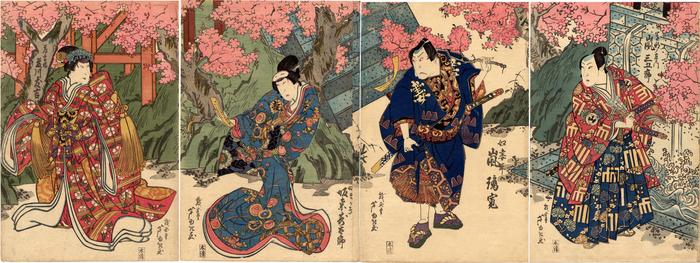Gigadō Ashiyuki (戯画堂芦ゆき) (artist )
From right to left: Arashi Sangorō IV (嵐三五郎) as Sonobe no Saemon (園部ノ左衛門), Arashi Rikan II (嵐璃寛) as the footman Tsumahei (奴妻平), Bandō Jūtarō (坂東寿太郎) as Magaki (まかき) and Fujikawa Tomokichi II (藤川友吉) as Usuyuki-hime (薄雪姫) - Viewing cherry blossoms at Kiyomizu
01/1829
40 in x 14.5 in (Overall dimensions) color woodbock print
Signed: Gigadō Ashiyuki ga (戲画堂芦幸画)
Publisher: Honya Seishichi (Marks 123 - seal 25-527)
Museum of Fine Arts, Boston
Lyon Collection - another copy of the single print of the yakko, second in from the right What the casual viewer of this tetraptych can't know, just by looking at it at first glance.
These four actors are playing the roles of what is basically the four most important figures in this play. If not the most important, then four of the figures that much of the play revolves around. At the far left is Princess Usuyuki who is in love with the handsome and dashing Sonobe no Saemon standing on the far right. In between are their two devoted servants: Magaki, Usuyuki's maid and Tsumahei, Saemon's devoted footman. On top of that, Magaki and Tsumahei are in love.
This should help the viewer to understand this arrangement of characters better. It should also be noted that in many of the Usuyuki plays Tsumahei provides a fair amount of comic relief.
In Act I of this play, Usuyuki has taken her ladies to Kiyomizu Temple to see its famous flowering cherry blossoms. While there Usuyuki is so inspired that she writes a poem and attaches it to one of the flowering branches. At the same time, Saemon sees her from a distance. He is there to present a specially made sword as a gift to the temple. He asks the abbot for permission to cut off one of the branches to take to his mother and is giver permission to do so. He cuts off the branch with Usuyuki's poem. She sees this and sends her maid with another poem slip to ask for the original poem back in exchange. This is done. You will notice that Magaki in this composition is holding a poem slip and that there is one attached to the severed branch that Tsumahei is holding over his shoulder. What we can't tell you is if the switch had been made yet, but there they are, the two poem slips. Now this composition makes much more sense.
****
The play represented here was Shin Usuyuki Monogatari (新うすゆき物語) performed at the Naka Theater in 1/1829. It was originally written for the puppet theater and staged for the first time in 5/1741 in Osaka. Three months later it was performed on the Kyōto stage.
****
The Arashi crest of a mandarin orange or tachibana appears toward the bottom of his robes. It looks like it was designed to be the flipped back purplish lining of this actor's dark blue robe. It should be noted that very early on the tachibana was used as a crest for the Ichimura line of actors.
****
How the character of Usuyuki has changed over time
When the character of Usuyuki first appeared she was one of the most passive female characters to be found in Japanese literature and theater, according to Torii Fumiko. (See 'The Stage Techniques of Tosa Joruri (XX): Usuyuki' [土佐浄瑠璃の脚色法(二十) : 薄雪].) However, in time she was morphed into a more proactive woman. "Usuyuki in Tosa Joruri is an active and passionate woman who expresses her self; she marries the person of her choice. This heroine stands at the turning point of the transformation of Japanese women into modern women. Moreover, she becomes a source of a new kind of characterization of "Usuyukimono" in the later joruiri and kabuki."
****
The name Usuyuki (薄雪) can be translated as 'light snowfall'.
Honya Seishichi (本屋清七) (publisher)
Fujikawa Tomokichi II (二代目藤川友吉: from 1/1810 to 12/1812 and again from 11/1813 to 10/1815 and again from 11/1819 to 7/1833) (actor)
Bandō Jūtarō I (初代坂東寿太郎: from 11/1825 to 12/1840) (actor)
actor prints (yakusha-e - 役者絵) (genre)
Kyōto-Osaka prints (kamigata-e - 上方絵) (genre)
Arashi Sangorō IV (四代目嵐三五郎: 2/1823-6/1837) (actor)
Arashi Rikan II (二代目嵐璃寛: 9/1828 - 6/1837) (actor)
Shin Usuyuki Monogatari (新うすゆき物語) (kabuki)
